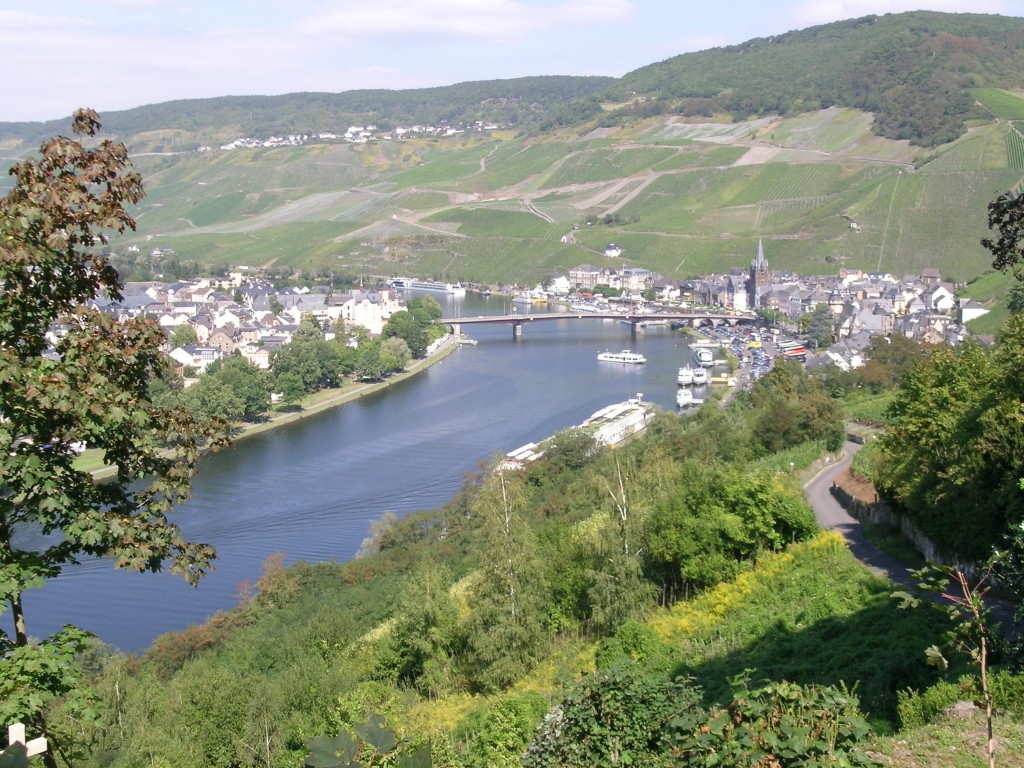
We’re a die-hard lot us riesling lovers, clinging to a great variety that appeals to few. We talk it up. We pore over the results of Canberra’s annual International Riesling Challenge. We admire Frankland Estate’s International Riesling Tasting. Then Coles liquor executive, Grant Ramage, reveals the sorry truth, “Riesling’s just not going anywhere. Nielsen data says sales are down nine per cent year-on-year to the end of August”.
In more gloomy riesling reality, the press release accompanying today’s wine of the week crows, “Sales of pinot gris/grigio have now overtaken riesling in this country”. Depressing news about a variety that more often than not produces ordinary wine.
We’re fishing for good riesling news, high on the variety after eight days in the central Mosel, Germany’s riesling heartland – source of the world’s most delicate, most profound rieslings.
We’ve carried these aromas and flavours in our head for over thirty years – memories born in the late seventies from tasting wines from the great 1976 vintage. What unforgettable wines they were, even if we knew little of the regions or names at the times.
The wines did the talking – gently fragrant kabinett and spaetlese rieslings, poised softly, ethereally on the palate, delivering intense flavours and a unique, perfect, thrilling balance between sweetness and dazzling, fresh acidity. Even the profound, sweet ausleses, beerenausleses and trockenbeerenausleses sat delicately on the palate, never cloying, never too sweet, but filling the room with their fragrance.
You can’t forget wines like that, and we didn’t. Though the selection included wines from the Rhine River, a few Mosel wines in particular etched their peculiar names in our minds – Bernkasteler Doctor, Wehlener Sonnenuhr and Graacher Himmelreich.
We were new in the trade at the time, but studied the vineyard maps, gained a basic understanding, and over the decades, enjoyed other vintages without ever losing the thrill of first discovery. These were great and unique wines.
But even then, long before the chardonnay or sauvignon blanc ages, selling German riesling in Australia proved difficult. It took years for Farmer Bros to move the 400 cases of 1976 it’d imported. David and Richard Farmer and staff probably drank more than they sold (I’m still grateful).
And nothing’s changed, says Grant Ramage, quoting the Nielsen year-to-August figures again. Sales of all German wines increased by 2.5 per cent in value but declined in volume, accounting for just one thousandth of wine sales in Australia.
Even in Germany, it’s not easy to find these home grown glories. In east and west Germany, in the weeks before arriving in the Mosel, we search supermarket shelves in vain. We find long lines of bland wines, German and imported, mostly priced between two and four euros.
At a tasting with renowned Mosel producer Dr Loosen, a German-based, English wine distributor confirms what we’ve feared. He tells us, “The Germans have no appreciation of what they’ve got. That’s why Ernie [Loosen] exports 70 per cent of his wine to America”.
But if sales of German riesling disperse in little wisps to admirers around the world, here in the central Mosel, up and downstream of Bernkastel, riesling rules, accounting for 60 per cent of the area’s 9,000 hectares of vines.
We didn’t come here for the other 40 per cent. However, because we’re there and we can, we taste a few examples of muller-thurgau (rivaner), elbling, pinot noir (spatburgunder), dornfelder and pinot blanc. But they’re not wines you’d travel 20,000 kilometres to taste.
We didn’t come to try the increasingly popular dry (trocken) rieslings either. But we do and conclude that the classic, delicate, semi-sweet versions – with their unique balance of acidity and sugar – remain the region’s great specialty.
Our visit coincides with the middle Mosel wine festival, so we taste dozens of wines simply by wandering from marquee to marqee strung along a riverfront road at Bernkastel. It’s an annual event, held each September shortly before vintage, and worth attending.
There we savour old friends, like J. J. Prum’s exquisite Wehlener Sonnenuhr Riesling Spaetlese 2007 at three euros a glass or 17 euros a bottle – amazingly modest prices for a wine of this stature.
We enjoy unfamiliar wines, too, and stop to chat with young winemaker Heiko Fass. Later we drive up to his underground cellars, built by his father in 1969, at Neumagen-Dhron. There we learn more about Fass rieslings from the Hofberger and Roterd vineyards, Dhron – and his recent access, through his wife’s family, to the great Goldtropfchen vineyard at Piesport, around the next bend of the Mosel, down stream.
Over the next days we drive upstream to the old Roman provincial capital, Trier, and downstream to Koblenz, where the Mosel flows into the Rhine. Our constant travelling companion, Hugh Johnson’s wonderful World Atlas of Wine, with its detailed contour maps, allows us to identify the great vineyards on the Mosel’s impossibly steep south, south east and south west facing slopes.
Our other constant companion is a desire to drink those beautiful rieslings, which we do in buckets. What we’re not expecting, though, is to taste, alongside those rieslings, an eclectic and great range of perfectly cellared whites and reds from Switzerland, Loire Valley, Washington State, Corton-Charlemagne, South Africa, Aix-en-Provence, Yarra Valley, Volnay, Charmes-Chambertin, Pomerol and St Estephe.
But we did. And that’s part of the continuing Mosel story next week.
Copyright © Chris Shanahan 2011
First published 5 October 2011 in The Canberra Times